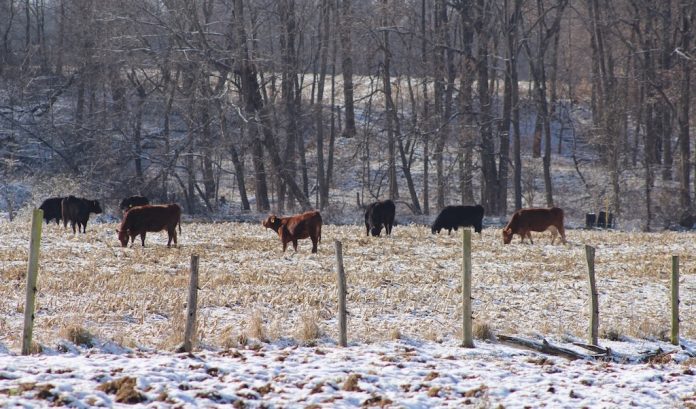The temperatures over the last few days have crept down around and below 0 degrees. Individuals with pets are struggling when it comes to letting them outside; what about livestock producers who have animals that are always outside?
Smaller animals such as poultry and sheep/goats may be struggling more than cattle and horses. There are a few precautions we can take during these frigid winter temperatures.
Quality shelter
Shelter is a very important structure that will protect livestock from the extreme cold. Younger and smaller animals are at a greater risk of being buried in snow when accumulations are high, so providing them protection is crucial.
Cold temperatures not accompanied with wind are usually not enough to affect performance of animals that are receiving full quality feed. Wind alone can cause the same effect on animals as exposure to a sudden drop in temperature.
Shelter will provide protection from wind gusts, but under extreme temperatures and winter storms, shelter alone is not enough to keep livestock at peak function and weight gain.
Water needs to be checked regularly to make sure it has not frozen. Adequate and accessible water sources need to be available all the time. If water needs to be transported, make sure equipment and a local water source is available. Heaters may also be used in water tanks to provide livestock with adequate water.
Equipment must be well maintained and protected so that it can be available for use. One major piece of equipment is vehicles.
Tractors or other vehicles that may be used to transport hay during the winter months need to be kept in working order. Cold weather can sometimes be detrimental to equipment, meaning it will require more maintenance and care.
Transporting bedding can be crucial, especially for younger, more vulnerable animals who need to be out of the ice and mud to remain as dry as possible.
Feed
Feed is another important aspect to animals maintaining performance in less-than-ideal weather conditions. Having abundant and accessible feed will allow animals to maintain their body temperature and be able to survive cold temperatures.
Feed usually accounts for the single largest input cost with winter feeding generally becoming the largest portion of this cost. Stored feeds such as hay normally cost producers three to five times as much as grazing a summer pasture or stockpiled feed in a paddock, when cost is calculated.
It’s therefore critical to keep the amount of stored feed fed to an acceptable minimum so costs are kept under control, but you must still feed enough hay to meet the nutritional needs of the animal.
Livestock will require more nutrients due to the colder temperatures increasing their energy output to stay warm. It is important to be aware of the nutrients that are in the hay we are feeding to ensure we are providing enough for survival and performance. Verifying that the winter feed is of good nutrient quality allows us to provide enough nutrients during the colder months.
Forage analysis
A critical step is to have a forage analysis done on your hay. I know we are in the beginning months of the year, but it is never to early to prepare. You can call your local extension office to inquire about sending samples of your forages to a laboratory for testing.
The knowledge of the quality of hay we are feeding can help in planning feed management strategies for winter to keep livestock in good health. It is important to test both what we perceive as high and low quality so we are able to balance rations and provide consistent quality hay with confidence.
In Monroe County, the local soil and water conservation district offers testing at a reduced price to promote their annual hay and silage contest. This contest was created for the county to aid in determining nutrient content and to help save on feeding costs.
Be sure to check with your local extension office to see if any assistance is available in your area so you too can obtain your forage analysis and be successful with your feed management plan.













